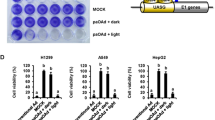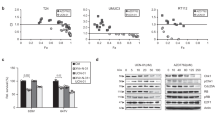Abstract
We have described three potential adenovirus type 5 (Ad5)-based replication-competent cancer gene therapy vectors named KD1, KD3, and VRX-007. All three vectors overexpress an Ad5 protein named Adenovirus Death Protein (ADP, also named E3–11.6 K protein). ADP is required for efficient lysis of Ad5-infected cells and spread of virus from cell to cell, and thus its overexpression increases the oncolytic activity of the vectors. KD1 and KD3 contain mutations in the Ad5 E1A gene that knock out binding of the E1A proteins to cellular p300/CBP and pRB; these mutations allow KD1 and KD3 to grow well in cancer cells but not in normal cells. VRX-007 has wild-type E1A. Here we report that radiation increases the oncolytic activity of KD1, KD3, and VRX-007. This increased activity was observed in cultured cells, and it was not because of radiation-induced replication of the vectors. The combination of radiation plus KD3 suppressed the growth of A549 lung adenocarcinoma xenografts in nude mice more efficiently than radiation alone or KD3 alone. The combination of ADP-overexpressing vectors and radiation may have potential in treating cancer.
This is a preview of subscription content, access via your institution
Access options
Subscribe to this journal
Receive 12 print issues and online access
$259.00 per year
only $21.58 per issue
Buy this article
- Purchase on Springer Link
- Instant access to full article PDF
Prices may be subject to local taxes which are calculated during checkout





Similar content being viewed by others
References
Alemany R, Balague C, Curiel DT . Replicative adenoviruses for cancer therapy. Nat Biotech. 2000;18:723–727.
McCormick F . Cancer gene therapy: Fringe or cutting edge? Nat Rev Cancer. 2001;1:130–141.
Kirn D, Martuza RL, Zwiebel J . Replication-selective virotherapy for cancer: biological principles, risk management and future directions. Nat Med. 2001;7:781–787.
Rodriguez R, Schuur ER, Lim HY, Henderson GA, Simons JW, Henderson DR . Prostate attenuated replication competent adenovirus (ARCA) CN706: a selective cytotoxic for prostate-specific antigen-positive prostate cancer cells. Cancer Res. 1997;57:2559–2563.
Yu DC, Sakamoto GT, Henderson DR . Identification of the transcriptional regulatory sequences of human kallikrein 2 and their use in the construction of Calydon virus 764, an attenuated replication competent adenovirus for prostate cancer therapy. Cancer Res. 1999;59:1498–1504.
Latham JPF, Searle PF, Mautner V, James ND . Prostate-specific antigen promoter/enhancer driven gene therapy for prostate cancer: construction and testing of a tissue-specific adenovirus vector. Cancer Res. 2000;60:334–341.
Hallenbeck PL, Chang Y-N, Hay C, Golightly D, Stewart D, Lin J, Phipps S, Chiang YL . A novel tumor-specific replication-restricted adenoviral vector for gene therapy of hepatocellular carcinoma. Hum Gene Ther. 1999;10:1721–1733.
Johnson L, Shen A, Boyle L, Kunich J, Pandey K, Lemmon M, Hermiston T, Geidlin M, McCormick F, Fattaey A . Selectively replicating adenoviruses targeting deregulated E2F activity are potent, systemic antitumor agents. Cancer Cell. 2002;1:325–337.
Benjamin R, Helman L, Meyers P, Reaman G . A phase I/II dose escalation and activity study of intravenous injections of OCaP1 for subjects with refractory osteosarcoma metastatic to lung. Human Gene Ther. 2001;12:1591–1593.
Matsubara S, Wada Y, Gardner TA, Egawa M, Park M-S, Hsieh C-L, Zhau HE, Kao C, Kamindo S, Gillenwater JY, Chung LWK . A conditional replication-competent adenoviral vector, Ad-OC-E1a, to cotarget prostate cancer and bone stroma in an experimental model of androgen-independent prostate cancer bone metastasis. Cancer Res. 2001;61:6012–6019.
Brunori M, Malerba M, Kashiwazaki H, Iggo R . Replicating adenoviruses that target tumors with constitutive activation of the wnt signaling pathway. J Virol. 2001;75: 2857–2865.
Fuerer C, Iggo R . Adenoviruses with Tcf binding sites in multiple early promoters show enhanced selectivity for tumour cells with constitutive activation of the wnt signalling pathway. Gene Ther. 2002;9:270–281.
Doronin K, Kuppuswamy M, Toth K, Tollefson AE, Krajcsi P, Krougljak V, Wold WSM . Tissue-specific, tumor-selective, replication-competent adenovirus vector for cancer gene therapy. J Virol. 2001;75:3314–3324.
Bischoff JR, Kirn DH, Williams A, Heise C, Horn S, Muna M, Ng L, Nye JA, Sampson-Johannes A, Fattaey A, McCormick F . An adenovirus mutant that replicates selectively in p53-deficient human tumor cells. Science. 1996;274:373–376.
Freytag SO, Rogulski KR, Paielli DL, Gilbert JD, Kim JH . A novel three-pronged approach to kill cancer cells selectively: concomitant viral, double suicide gene, and radiotherapy. Hum Gene Ther. 1998;9:1323–1333.
Shinoura N, Yoshida Y, Tsunoda R, Ohashi M, Zhang W, Asai A, Kirino T, Hamada H . Highly augmented cytopathic effect of a fiber-mutant E1B-defective adenovirus for gene therapy of gliomas. Cancer Res. 1999;59:3411–3416.
Goodrum FD, Ornelles DA . The early region 1B 55-kilodalton oncoprotein of adenovirus relieves growth restrictions imposed on viral replication by the cell cycle. J Virol. 1997;71:548–561.
Goodrum FD, Ornelles DA . p53 status does not determine outcome of E1B 55-kilodalton mutant adenovirus lytic infection. J Virol. 1998;72:9479–9490.
Harada JN, Berk AJ . p53-independent and -dependent requirements for E1B-55 K in adenovirus type 5 replication. J Virol. 1999;73:5333–5344.
Dix BR, Edwards SJ, Braithwaite AW . Does the antitumor adenovirus ONYX-015/dl1520 selectively target cells defective in the p53 pathway? J Virol. 2001;75:5443–5447.
Ries SJ, Brandts CH, Chung AS, Biederer CH, Hann BC, Lipner EM, McCormick F, Korn WM . Loss of p14arf in tumor cells facilitates replication of the adenovirus mutant dl1520 (ONYX-015). Nat Med. 2000;6:1128–1133.
Doronin K, Toth K, Kuppuswamy M, Ward P, Tollefson AE, Wold WSM . Tumor-specific, replication-competent adenovirus vectors overexpressing the adenovirus death protein. J Virol. 2000;74:6147–6155.
Fueyo J, Gomez-Manzano C, Alemany R, Lee PS, McDonnell TJ, Mitlianga P, Shi YX, Levin VA, Yung WK, Kyritsis AP . A mutant oncolytic adenovirus targeting the Rb pathway produces anti-glioma effect in vivo. Oncogene. 2000;19:2–12.
Heise C, Hermiston T, Johnson L, Brooks G, Sampson-Johannes A, Williams A, Hawkins L, Kirn D . An adenovirus E1A mutant that demonstrates potent and selective systemic anti-tumoral efficacy. Nat Med. 2000;6: 1134–1139.
Tollefson AE, Ryerse JS, Scaria A, Hermiston TW, Wold WSM . The E3-11.6 kDa adenovirus death protein (ADP) is required for efficient cell death: characterization of cells infected with adp mutants. Virology. 1996;220:152–162.
Tollefson AE, Scaria A, Hermiston TW, Ryerse JS, Wold LJ, Wold WSM . The adenovirus death protein (E3-11.6K) is required at very late stages of infection for efficient cell lysis and release of adenovirus from infected cells. J Virol. 1996; 70:2296–2306.
Heise C, Sampson-Johannes A, Williams A, McCormick F, Von Hoff DD, Kirn DH . ONYX-015, an E1B gene-attenuated adenovirus, causes tumor-specific cytolysis and antitumoral efficacy that can be augmented by standard chemotherapeutic agents. Nat Med. 1997;3:639–645.
Rogulski KR, Wing MS, Paielli DL, Gilbert JD, Kim JH, Freytag SO . Double suicide gene therapy augments the antitumor activity of a replication-competent lytic adenovirus through enhanced cytotoxicity and radiosensitization. Hum Gene Ther. 2000;11:67–76.
Rogulski KR, Freytag SO, Zhang K, Gilbert JD, Paielli DL, Kim JH, Heise CC, Kirn DH . In vivo antitumor activity of ONYX-015 is influenced by p53 status and is augmented by radiotherapy. Cancer Res. 2000;60:1193–1196.
Chen Y, DeWeese T, Dilley J, Zhang Y, Li Y, Ramesh N, Lee J, Pennathur-Das R, Radzyminski J, Wypych J, Brignetti D, Scott S, Stephens J, Karpf DB, Henderson DR, De-Chao Y . CV706, a prostate cancer-specific adenovirus variant, in combination with radiotherapy produces synergistic antitumor efficacy without increasing toxicity. Cancer Res. 2001;61:5453–5460.
DeWeese T, van der Poel H, Li S, Mikhak B, Drew R, Goemann M, Hamper U, DeJong R, Detorie N, Rodriguez R, Haulk T, Demarzo AM, Piantadosi S, Yu D-C, Chen Y, Henderson DR, Carducci MA, Nelson WG, Simons JW . A Phase I trial of CV706, a replication-competent, PSA selective oncolytic adenovirus, for the treatment of locally recurrent prostate cancer following radiation therapy. Cancer Res. 2001;61:7464–7472.
Khuri F, Nemunaitis J, Ganly I, Arseneau J, Tannock I, Romel L, Gore M, Ironside J, MacDougall RH, Heise C, Randley B, Gillenwater A, Bruso P, Kaye S, Hong W, Kirn D . A controlled trial of intratumoral ONYX-015, a selectively replicating adenovirus, in combination with cisplatin and 5-fluorouracil in patients with recurrent head and neck cancer. Nat Med. 2000;6:879–885.
Doronin K, Toth K, Kuppuswamy M, Krajcsi P, Tollefson AE, Wold WSM . Overexpression of the ADP (E3-11.6K) protein increases cell lysis and spread of adenovirus. Virology, in press.
Sanchez-Prieto RQM, Cano A, Leonart ML, Martin P, Anaya A, Cajal SR . Carcinoma cell lines become sensitive to DNA-damaging agents by the expression of the adenovirus E1A gene. Oncogene. 1996;13:1083–1092.
Shao R, Karunagaran D, Zhou BP, Li K, Lo S-S, Deng J, Chiao P, Hung M-C . Inhibition of nuclear factor-kB activity is involved in E1A-mediated sensitization of radiation-induced apoptosis. J Biol Chem. 1997;272:32739–32742.
Turnell AS, Grand RJ, Gorbea C, Zhang XL, Wang W, Mymryk JS, Gallimore PH . Regulation of the 26S proteasome by adenovirus E1A. EMBO J. 2000;19:4759–4773.
Russo SM, Tepper JE, Baldwin AS, Liu R, Adams J, Elliott PE, Cusack JC . Enhancement of radiosensitivity by proteasome inhibition: Implications for a role of NF-kB. Int. J Radiat Oncol. 2001;50:183–193.
Pajonk F, Pajonk K, McBride WH . Inhibition of NF-kB, clonogenicity, and radiosensitivity of human cancer cells. J Natl. Cancer Inst. 1999;91:1956–1960.
Shao R, Tsai EM, Wei K, von Lindern R, Chen Y-H, Makino K, Hung M-C . E1A inhibition of radiation-induced NF-kB activity through suppression of IKK activity and IkB degradation, independent of Akt activiation. Cancer Res. 2001;61:7413–7416.
Acknowledgements
We thank Chris Wells and Meribeth Broadway for technical assistance. This research was supported by grants CA71704, CA58538, and CA81829 from the National Institutes of Health.
Author information
Authors and Affiliations
Corresponding author
Rights and permissions
About this article
Cite this article
Toth, K., Tarakanova, V., Doronin, K. et al. Radiation increases the activity of oncolytic adenovirus cancer gene therapy vectors that overexpress the ADP (E3-11.6K) protein. Cancer Gene Ther 10, 193–200 (2003). https://doi.org/10.1038/sj.cgt.7700555
Received:
Published:
Issue Date:
DOI: https://doi.org/10.1038/sj.cgt.7700555
Keywords
This article is cited by
-
A phase 1 trial of the safety, tolerability and biological effects of intravenous Enadenotucirev, a novel oncolytic virus, in combination with chemoradiotherapy in locally advanced rectal cancer (CEDAR)
Radiation Oncology (2020)
-
The effects of radiation on antitumor efficacy of an oncolytic adenovirus vector in the Syrian hamster model
Cancer Gene Therapy (2013)
-
A fully replication-competent adenovirus vector with enhanced oncolytic properties
Cancer Gene Therapy (2010)
-
New pancreatic carcinoma model for studying oncolytic adenoviruses in the permissive Syrian hamster
Cancer Gene Therapy (2009)
-
Armed replicating adenoviruses for cancer virotherapy
Cancer Gene Therapy (2009)



